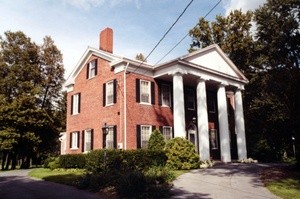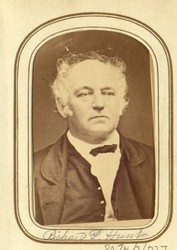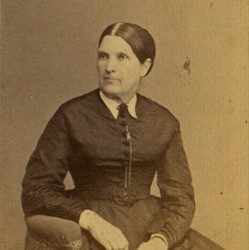The Richard and Jane Hunt House (Abolitionists & Suffragists)
Introduction
Text-to-speech Audio
Richard P. Hunt moved to Waterloo from Westchester in 1821. Hunt was a young man, but became successful relatively quickly, and built a large brick home that became a lively center of the town’s social life. Hunt was a Quaker, and though he was a wealthy businessman, his Quaker faith had a powerful influence on his life and he lived by the progressive beliefs of the church. Consequently, both Hicks and his fourth wife, Jane, became an active abolitionists and supporters of women suffrage. It was in the Hunt's home that Jane Hunt, Elizabeth Cady Stanton, Lucretia Mott, and several other Quaker women met in July of 1848 to plan the Seneca Falls Convention.
Images
The home of Richard and Jane Hunt

Richard P. Hunt

Jane Hunt

Backstory and Context
Text-to-speech Audio
In the 1840s, much of western upstate New York was the site of a wave of social and religious reforms. Some of those reforms were driven by the many Quakers in the area. Officially known as the Society of Friends, Quakers had a number of beliefs that, at the time, caused them to be the object of scorn and even outright persecution. They believed in equality and community, and because of this, they treated men and women equally, did not recognize class distinctions, and opposed the institution of slavery. These ideas are hardly radical today, but in the 1800s, non-Quakers viewed their beliefs with suspicion and hostility. Waterloo was, for a time, home to a particularly progressive branch of the Quaker faith, many of whom were outspoken supporters of abolition and suffrage.
Among the most influential of the Waterloo Quakers was Richard P. Hunt, who moved to Waterloo in 1821. Hunt, like most of the young Quakers in the area, were affiliated with the Junius Monthly Meeting of Friends in Waterloo, although they would late be a part of the more radical Hicksite Quakers, following a split over doctrine. Many of these Quakers were also instrumental in the early economic development of the town, and Hunt soon became one of the wealthiest men in Waterloo. Among Hunt's holdings were several farms located between Waterloo and Seneca Falls, as well as more than 900 acres in LaSalle County. Although Hunt would describe himself as a farmer throughout his life, he was an industrialist; he was a prime investor in the Waterloo Woollen Factory and was owner and developer of the Hunt Block, an area of commerccial establishments that he constructed in downtown Waterloo. In 1829, he moved to the large, Federal-style home on Main Street, a tangible reflection of his increasing wealth.
But Hunt's wealth did not prevent his from being engaged in the most important social issues of the day, including women's suffrage and slavery. Regarding slavery, he supported immediate abolition and was a supporter of William Lloyd Garrison, who was regarded as the most radical abolitionist. He knew and corresponded with leading abolitionists, including Garrison and Gerrit Smith, and the home on Main Street is believed to have been a station on the Underground Railroad.
Hunt was married fourt times, and his fourth wife, Jane Master, was a fierce supporter of suffrage. Like her husband, Jane Hunt was a radical Quaker who believed in social reform. In 1848, Jane Hunt invited Elizabeth Cady Stanton, a longtime supporter of suffrage, to her home to meet with Lucretia Mott as well as several other Quaker women. Stanton and Mott had become acquainted several years earlier at the World Anti-Slavery Convention in London and were humiliated and enraged by the treatement of women, who were not allowed to participate in the convention. It was at this informal gathering that the Seneca Falls Convention was planned, although Jane Hunt is often overlooked in accounts of the event. Both Jane and Richard Hunt attended the convention later that year, and both signed the Declaration of Sentiments.
For the remainder of their lives, the Hunts continued to be involved in progressive causes. They joined with other Quakers in passing resolutions against slavery, alcohol, humane treatment of prisoners, and equal educational opportunities. Jane outlived her husband by 33 years and after his death, she continued his tradition of philanthropy and community involvement, giving large amounts of money to the town of Waterlool.
Sources
Richard P. Hunt , NPS. Accessed March 6th 2022. https://www.nps.gov/wori/learn/historyculture/richard-p-hunt.htm.
Quaker Influence , Accessed March 6th 2022. https://www.nps.gov/wori/learn/historyculture/quaker-influence.htm.
Jane Hunt , History of American Women . Accessed March 6th 2022. https://www.womenhistoryblog.com/2014/12/jane-hunt.html.
